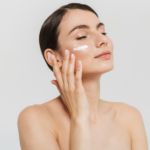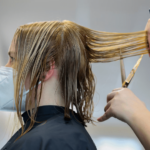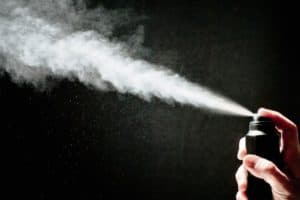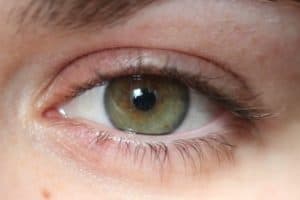In the morning, when you apply your moisturizer and primer, how much time between each is ideal? How long to wait between moisturizer and primer?
Apply primer after your moisturizer has absorbed fully, which should only take about 1 or 2 minutes. The time it takes for the moisturizer to absorb depends on how thick the moisturizer is and how thick you apply it.
Read on to learn more about how long to wait between applying your moisturizer and primer.
Also, for an excellent moisturizer, take a look at our top pick, the Malin Goetz Vitamin Face Moisturizer:
Click here to see it on Amazon.
How Long Does It Take for Moisturizer to Absorb?
Dermatologists agree that setting up a timer or even counting in your head is not necessary when you are in between applying primer and moisturizer.
You can apply your primer as soon as you feel that your moisturizer has completely dried up because this means that the product is already absorbed into your skin.
This time will take about 1 or 2 minutes, up to a full five minutes, depending on how thick the moisturizer is and how thick you apply it (the thicker it is, the longer it takes to absorb).
To have a better idea of how long it takes for moisturizers to absorb, let’s look at what moisturizers are. Also, how do moisturizers help you maintain hydrated and smooth skin?
Dry skin is a result of the skin barrier breaking down and not being able to effectively keep moisture locked in. This is a result of using harsh soaps, habitual bathing, aging, cold climate, or skin conditions such as eczema. Luckily, dry skin can be treated with a moisturizer.
A moisturizer prevents the evaporation of water from the deeper layers of the skin by forming a coating on the surface of your stratum corneum – the outermost layer of the epidermis.
The outermost layer of our skin must be composed of at least 10% to 30% water for it to have a smooth feel to it. Water plays a vital role in helping enzymes shed dead skin cells, and without it, your skin will crack.
Moisturizer supplies a small amount of water to your skin while its “greasy” component prevents water from evaporating from your skin.
With the regulation of water content, your skin is able to maintain a barrier to protect you from pathogens, dirt, damage from the sun, and pollution while also protecting itself from drying up and becoming rigid.
Moisturizers available in the market usually contain the following ingredients:
Water:
Some of the water contained in moisturizers evaporate, while some are successfully bound to the stratum corneum. For your skin to hold in the water, an oily substance is needed.
Humectants:
Attracts water into the outermost layer of your skin. Humectants include ceramides ( ser-A-mids), glycerin, sorbitol, hyaluronic acid, lecithin, honey, and panthenol (or vitamin B5). Humectants are more effective when used with occlusive ingredients.
Occlusives:
Prevent water from evaporating from the outermost layer of your skin. Petrolatum, fatty substances like cetyl alcohol, lanolin, lecithin, mineral oil, paraffin, stearic acid, dimethicone, and Cyclomethicone. Petrolatum (petroleum jelly) is considered the best at holding in water, followed by lanolin, mineral oil, and silicones.
Emollients:
Emollients’ function is not to moisturize your skin but to make your skin feel smooth. Emollients contain oil, water, and emulsifier. Some occlusives also function as an emollient; an example of this is dimethicone. Some alcohols, such as octyldodecanol, function as emollients.
Vitamins:
Retinyl palmitate is the form of vitamin A that is usually included in a moisturizer. It also functions as a humectant. Retinyl palmitate, as compared to retinol, is not as active in reducing your fine lines and wrinkles. Vitamin C and Vitamin E are also usually included due to their antioxidant properties.
Lactic Acid:
It helps in softening the outer layer of your skin, especially on the heel.
Figure 1. Occlusives seal moisture into your skin – the top and bottom layers:
Figure 2. Humectants attract moisture from the outside environment and lock the moisture in, preventing it from escaping:
Figure 3. Emollients fill the rough spots of the Epidermis and Dermis, making your skin feel smooth.
Moisturizers, when applied to your skin, should feel silky and glide naturally on your skin. This is often due to Dimethicone, an oil-free emollient and occlusive.
Moisturizers should be almost immediately absorbed by your skin, relieving the dryness and tightness of your skin. After applying the moisturizer, you should not feel oily or feel like you applied a greasy layer on your skin.
Perform a small patch test on a small part of your skin before using a new moisturizer. After cleansing, moisturize immediately. Cleansing is a very important step as it prepares your skin for the moisturizer.
Set up a strict morning and night skincare routine that works for you and your skin. Include in this routine cleansing and then following with the moisturizer.
A good quality moisturizer will absorb quickly and will lock in moisture. It won’t feel too greasy or leave the skin too dry after applying.
My go-to recommendation for a high-quality moisturizer is the Malin + Goetz Vitamin E Face Moisturizer.
Click here to see it on Amazon.
It is packed with beneficial ingredients, including vitamin E, vitamin B5, and soothing chamomile. It feels great on the skin and absorbs very quickly, within seconds.
Another incredible moisturizer is the StriVectin Advanced Retinol Day Moisturizer SPF 30.
Click here to see it on Amazon.
This moisturizer also brings so much more than just hydration. It provides SPF 30 along with an anti-aging formula that reduces the signs of wrinkles and fine lines. It also absorbs very quickly in the skin, leaving you ready to apply your primer within seconds.
How to Apply Primer After Moisturizer?
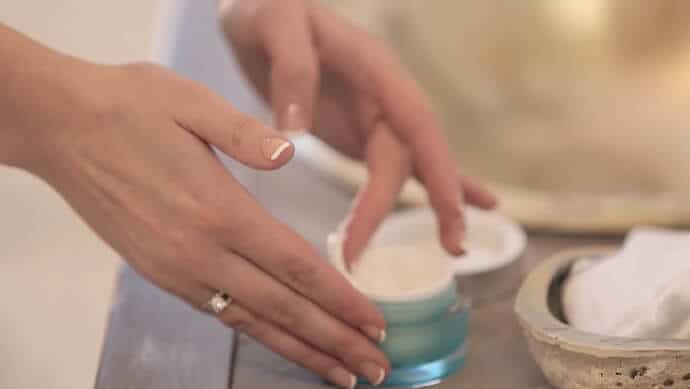
What is a primer? Do you really need it when you can retouch it once your makeup fades? How do you apply primer after moisturizing?
A primer is available as cream, gel, and powder. Its primary function is to prepare your skin for your foundation, so it is applied before putting on makeup. Primer helps your makeup look even and last long.
Applying primer is often seen as an unnecessary step because why would you need to make your makeup stay longer if you can retouch it, right?
However, aside from the many benefits of a primer, primer also works in treating skin concerns (hydrating primer, anti-aging primer, color-correcting primer, and others are available on the market).
A primer is a must-have, especially in warm, humid, hot areas and even in cold areas. Several primers have silicone-based polymers such as dimethicone in their formula.
Make sure you test products with dimethicone on a small part of your skin because some people reported that they are allergic to it. Another factor that you should consider in choosing a primer is if it is compatible with your foundation.
A cakey-looking makeup will result when your primer turns out to be not compatible with your foundation.
My new favorite primer is the Correcting Skin Primerr. This primer gives the perfect finish, feels very light, and goes on clear and smooth.
Click here to see it on Amazon.
Perhaps the biggest rule when applying primer is to always apply it after you moisturize your skin. It doesn’t matter if you are applying the primer to your face, lips, eyes, or lashes.
Always apply the primer after moisturizing and before putting on your makeup.
Make sure that your moisturizer is completely and fully absorbed by your skin before you apply a primer because applying a primer when your face is still wet from moisturizer will result in an uneven layer of primer. A primer can be all by itself if you want to achieve a “no-makeup look.”
A primer prepares your face for makeup by absorbing the excess oil present on your skin, leaving a smooth canvas for your makeup. Without a primer, the oil will make your makeup have a patchy effect.
You can also apply primer to a specific area of your face in order to make wrinkles, enlarged pores, or blemishes disappear. The primer, which has nude or white tones, also makes the color of your makeup become more vibrant.
For your face, you only need a small amount (pea-sized). People with dry skin can handle a larger amount of primer because their skin absorbs primer quickly, while people with oily skin should stick to a small amount. Too much primer can potentially clog your skin.
Use your clean fingertips or a sponge to apply the primer to large areas of your face. For smaller areas, such as eyelids and under the lashes, you can use a brush.
Using your fingertips while applying primer will make your blood circulation better while also ensuring that you applied your primer evenly. Wait one minute or until the primer is fully dry before you start applying your foundation.
Some people think that primers don’t significantly make their makeup look vibrant and last long and consider it a dispensable step in their skincare routine, but maybe they just haven’t found a compatible primer for them.
If you decide that you need a primer, make sure to read up on the brands available on the market and get the best one for your skin type and condition.
Conclusion – How Long to Wait Between Moisturizer and Primer?
The primer should be applied after the moisturizer is fully absorbed in the skin. This should take about 30 seconds to 1 minute. The time it takes to absorb depends on how thick the moisturizer is and how thick you apply it.
The skin as an organ is very good at absorbing different types of products all at once. After applying moisturizer to your face, you only have to wait after it is completely dry, which is about a minute, and then you should be good to apply the primer.
This interval also depends on the quality and type of moisturizer you are currently using.
The main rule when applying primer is to add it after moisturizing, not before. Also, don’t apply too thick of a layer. Lastly, remember to choose a moisturizer that isn’t too oily or greasy, or it will take much longer to absorb properly.





